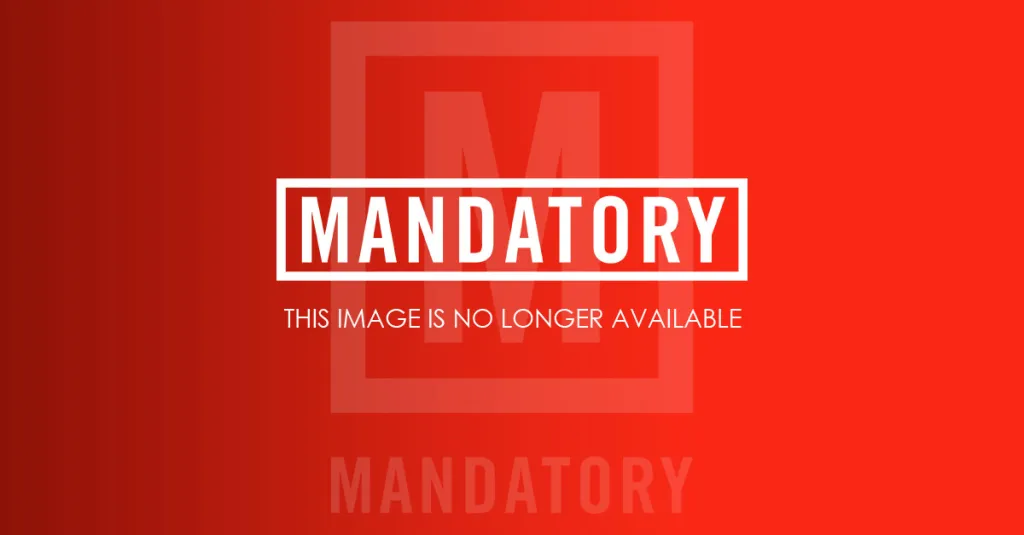In 1971 when Five was filmed, Romare Bearden was the best known of the artists profiled in this short, illuminating documentary. Today he’s still the most written about and studied of the group, and has the highest profile arts legacy. The film nods toward his stature by placing him in the headliner spot, making his the last interview. But the brisk, succinct portraits are all given the same weight. The artists – Bearden; Betty Blayton; Charles White; Barbara Chase-Riboud; Richard Hunt – are taken equally seriously, given equal space to comment on their art practice and their life, and how the two intersect. The film is a potent reminder of the history of black American visual artists – from painting to sculpture, from representational to abstract, with blackness at the center of it all.

Bigband Jazzman by Betty Blayton 1974/2004. Courtesy Betty Blayton
The downside to the brevity of each profile is that key biographical background (and thus crucial context) is sometimes left out, and the omissions – family history, kind and level of education, just how they were able to break into the art world (to the extent they did) – vary from subject to subject. So we have Charles White and Richard Hunt talking with pride about their children and the role fatherhood plays in their creativity, but get almost nothing at all on the personal life of Betty Blayton and the ways her creativity intersects with the rest of her life. (It is admittedly an interesting twist on the ways male and female artists are framed in conversation about their private and professional lives.) We learn that Chase-Rimboud (who in addition to the painting and sculpture shown in the film is a poet and novelist) has lived in Paris since 1961 – thus making her the embodiment of the black American artist as expatriate – but nothing about how or why she ended up there in the first place.

Richard Hunt. Photo by Taylor Glascock for Wall Street Journal.
The pros far outweigh the cons of the film, however. There’s Bearden’s hisoricizing of himself as a young artist in Depression-era Harlem, moving amongst the bright lights of the Harlem Renaissance. There is an extraordinary exchange between a black male and white male student in White’s classroom as the two discuss race, perception and the possibilities of true communication across racial lines. But what really makes the film so important is the way it captures the sometime laborious process of creation – from Hunt and some cohorts painstakingly casting a steel sculpture to the almost reverent hush of silence that falls as Blayton works on a painting and gets lost in the process. Perhaps the greatest value of the film is that it whets your appetite, makes you want to know more about the work and lives of everyone it profiles.
Lead photo 110 St Harlem Blues, by Romare Bearden, courtesy DC Moore Gallery
Previously on Art Doc of the Week:
Art Doc of the Week
-
Art Doc of the Week | Los Punks: We Are All We Have

The award-winning doc looks at Los Angeles’ 40-year-old punk scene.
Photo: Angela Boatwright
-
Art Doc of the Week | McQueen and I

The late fashion designer Alexander McQueen’s life was as unconventional as his iconic shows.
Photo: Alexander McQueen: Savage Beauty
-
Art Doc of the Week | Who Is Poly Styrene?

The late British-Somali punk icon was vulnerable in her feminist art.
Image Courtesy the Artist Estate
-
Art Doc of the Week | Eva Hesse

The new documentary on the on the late visual artist is both informative and soulful.
Image Courtesy the Filmmaker
-
Art Doc of the Week | Packed in a Trunk

Edith Lake Wilkinson’s great niece investigates why the painter was institutionalized for seemingly no reason.
Photo: Wolfe Video
-
Art Doc of the Week | The Kate Bush Story

The 2014 BBC documentary on the reclusive pop star lets her high-profile fans swoon all over her.
Photo: Peter Mazel / Sunshine
-
Art Doc of the Week | Nikki Giovanni and Muhammad Ali in Conversation

The ionic poet interviews and is charmed by the sports legend for Soul talk show.
Photo: Getty Images
-
Art Doc of the Week | They Will Have to Kill Us First

Malian musicians use their music to stand up to Islamic fundamentalists.
Photo: BBC Worldwide
-
Art Doc of the Week | Step Up and Be Vocal

The 2001 film looks at the role punk played and plays in shaping some queer and feminist identities.
Photo: PansyDivision.com
-
Art Doc of the Week | Mapplethorpe: Look at the Pictures

The first ever documentary on Robert Mapplethorpe makes the case for his art and legacy while showing his warts and all.
Photo: J. Paul Getty Trust / LACMA / Robert Mapplethorpe Foundation
-
Art Doc of the Week | Parliament Funkadelic: One Nation Under A Groove

Director Yvonne Smith traces funk from its doo-wop origins to its role as a building-block of hip-hop.
Photo: GeorgeClinton.com
-
Art Doc of the Week | Pete Seeger: The Power of Song

An OG political protest singer has much to teach us today.
Photo: Reuters
-
Art Doc of the Week | The Post Impressionists: Munch

Edvard Munch was a poster boy for the idea of the artist as brilliant, immeasurably tortured soul.
-
Art Doc of the Week | Detroit, Vogue

Director Mollie Mills’s short doc on Detroit’s current ball culture is high on visual impact, skimpy on substance.
Photo: Vogue, Detroit
-
Art Doc of the Week | Colored Frames
 The paintings highlighted in Lerone D. Wilson’s film are pulled into deep conversation with the complex realities of black life.
The paintings highlighted in Lerone D. Wilson’s film are pulled into deep conversation with the complex realities of black life.Photo: Colored Frames
-
Art Doc of the Week | Spirits of Rebellion

Filmmaker Zeinabu Irene Davis’ documentary on filmmakers of the LA Rebellion is timely and illuminating.
Photo: Spirits of Rebellion / Julie Dash
-
Art Doc of the Week | Five

The 1971 documentary gives an overview of five African American visual artists as the bloody ‘60s turn into the hopeful ‘70s.
Photo: 110 St Harlem Blues, by Romare Bearden, courtesy DC Moore Gallery
-
Art Doc of the Week | Masters of Photography: Diane Arbus

This 1972 documentary filmed one year after the photographer’s suicide is intimate and revealing.
Top Photo: Roz Kelly / Getty Images
-
Art Doc of the Week | Dorothea Lange: An American Odyssey

The iconic photographer’s images of 20th century Depression-era America speak to current battles around class, race, immigration, and poverty.
Photo: Dorothea Lange
-
Art Doc of the Week | Out and Bad: London’s LGBT Dancehall Scene

The struggles and joys of forging queer identity within dancehall culture.
Photo: Dazed/Bernard Miller
-
Art Doc of the Week | And When I Die, I Won't Stay Dead

Director Billy Woodberry’s poetic take on the life and work of beat poet Bob Kaufman.
Photo: Billy Woodberry
-
Art Doc of the Week | The Sound of Redemption

Director N.C. Heikin turns saxophonist Frank Morgan’s life into one of 2015’s best documentaries.
-
Art Doc of the Week | It Came from Kuchar

The Bronx-raised Kuchar twins helped pioneer American underground film.
Photo: Indie Pix
-
Art Doc of the Week | Tamara de Lempicka

The visionary artist, an OG Material Girl, is still struggling to get art world respect.
Photo: http://www.delempicka.org/
-
Art Doc of the Week | Jaco

A documentary on the life and music of Jaco Pastorius also probes link between mental illness and creativity.
Photo: JacoPastorius.com
-
Art Doc of the Week | Janis Joplin: Little Girl Blue

A new documentary on the late rock icon digs beneath the lore to find a complex woman and artist.
Photo: Evening Standard/Getty Images
-
Art Doc of the Week | The Many Faces of Billie Holiday

Lady Day was much more than her blues, as this documentary makes clear.
Photo: The William P. Gottlieb Collection
-
Art Doc of the Week | Anita Sarko

The legendary DJ’s words on art, culture and creativity resonate powerfully in the wake of her recent death.
Photo: Svetlana Samoshina
-
Art Doc of the Week | Antonio Gaudi

Filmmaker Hiroshi Teshigahara lets out his inner fanboy as he pays tribute to his hero, iconic architect Antonio Gaudi.
Photo: The Criterion Collection
-
Art Doc of the Week | Poetry of Resilience

Katja Esson's documentary allows poets to reclaim the depth and possibilities of art.
Photo: Jeremy Sutton Hibbert





